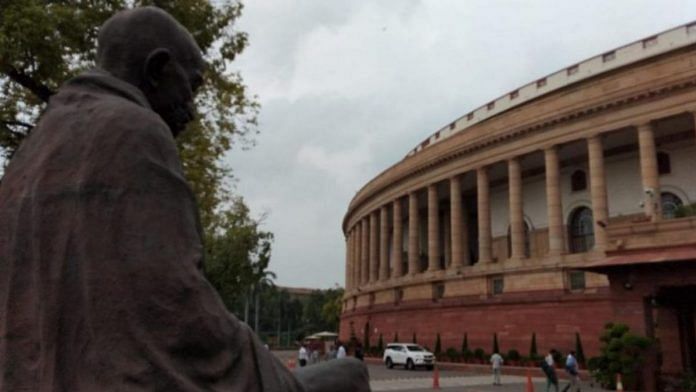New Delhi: Rajya Sabha and Lok Sabha Television — the two TV channels that broadcast the proceedings of the upper and lower Houses of Parliament, respectively — have been formally merged into a single entity called ‘Sansad Television’ from Monday.
According to an order dated 1 March 2021, issued by the new channel, the decision was jointly taken by Rajya Sabha Chairman M. Venkaiah Naidu and Lok Sabha Speaker Om Birla. A retired IAS officer of the 1986 batch, Ravi Capoor, has been appointed as Sansad TV Chief Executive Officer for one year.
Capoor has earlier served in the ministries of commerce, textiles and petroleum. He will be responsible for working out the final details of the merger.
Speaking to ThePrint, officials in the erstwhile Lok Sabha TV (LSTV) and Rajya Sabha TV (RSTV) said the merger had been under discussion for years, and was meant to ease the financial burden resulting from “duplicacy of efforts and resources” between the two channels.
It is unlikely, sources added, that the merger will lead to any major job cuts.
Sources in the government told ThePrint that there could be two channels under Sansad TV, to give equal weight to live proceedings of both Houses, among other reasons.
In a separate order issued Monday, the Rajya Sabha secretariat terminated the services of channel CEO Manoj Kumar Pandey. He was a member of the panel formed in 2019 to chalk out the modalities and prepare guidelines for the merger.
Manoj K. Arora, an IRS officer, has been serving as interim editor-in-chief and Chief Executive of Lok Sabha TV since November last year.
Also Read: Modi told Hamid Ansari that the Rajya Sabha TV wasn’t favourable to the government
Why the decision?
Lok Sabha Television was launched in 2006 by then Speaker Somnath Chatterjee, while Rajya Sabha TV hit the airwaves in 2011.
Apart from broadcasting the proceedings of both Houses of Parliament, the channels aired discussions and other programmes on a range of topics. According to sources in the two channels, the secretariats of the two Houses started deliberations on the merger in 2017.
On 7 November 2019, a committee was constituted and tasked with chalking out the modalities of the merger, and preparing guidelines for pooling of resources and technology.
The panel was headed by former Prasar Bharati Chairman A. Surya Prakash, and its members included additional secretary to the Rajya Sabha Secretariat A.A. Rao, Ganpati Bhatt of the Lok Sabha Secretariat, RSTV financial adviser Shikha Darbari, Manoj Kumar Pandey, and Dr Aashish Joshi, former LSTV CEO. The committee held several sessions with parliamentarians across parties.
A senior official associated with LSTV told ThePrint that the panel said in its report, submitted last year, that there should be just one integrated channel for Parliament.
“There was a lot of duplicacy of efforts and resources between the channels and this was leading to an additional financial burden. The merger came through because of that,” the official said.
“For instance, the office space hired by RSTV at Talkatora Stadium had Rs 30 crore as rent, which was later reduced to around Rs 16 crore, but that was also too high,” the official added.
The new Sansad TV, the official said, will function from the same space as LSTV at Delhi’s Mahadev Road.
Panel chair Surya Prakash described the merger as a welcome step that will provide a more integrated approach to the parliamentary content that is broadcast.
“It will reduce additional burden on finances by pooling in the resources of both the channels and synergising the broadcast of parliamentary proceedings through an integrated channel that will not compete with any private channel and will have a different mandate,” he said.
Former editor-in-chief and CEO of LSTV Joshi offered a similar assessment, saying the step will go a long way towards synergising parliamentary content, and reduce additional financial burden.
How will the move pan out?
Sources in the channels said the merger panel had said in its report that there should be two separate channels under Sansad TV — Sansad 1 and Sansad 2. This is aimed at serving two purposes — to ensure parliamentary proceedings of both Houses can be telecast simultaneously, and, in times when Parliament is not in session, to cater to English and Hindi audiences.
A senior official privy to the report said Sansad 1 was mooted as the channel for Lok Sabha proceedings and Sansad 2 for Rajya Sabha proceedings.
When Parliament is not in session, the first channel can air Hindi content and the second, English content, the panel is believed to have recommended.
“The Sansad TV umbrella… will be headed by a single person. But there are plans to have two different channels under it on the lines of the recommendations of the panel so that content of both Houses can be aired equally and all audiences can be catered to,” the official said.
A lot of the programmes on Rajya Sabha TV, the official sought to note, were in English. Both channels are likely to have separate editorial heads.
A few sources said a Doordarshan channel could also be engaged to air some of the RSTV proceedings. However, several aspects with respect to human resources and funds will now need to be streamlined, the aforementioned official added.
Apart from airing the parliamentary proceedings of the two Houses, Sansad TV will air multiple daily and weekly programmes on news and current affairs, on the themes of democracy, and awareness of the Constitution, among others. During the times Parliament is not in session, there will be several common programmes telecast by the channels, sources said.
Also Read: When Mahua Moitra speaks in Parliament, Lok Sabha TV goes from low definition to Ultra HD




Good effort by Government Why it not merge this with Doordarshan?